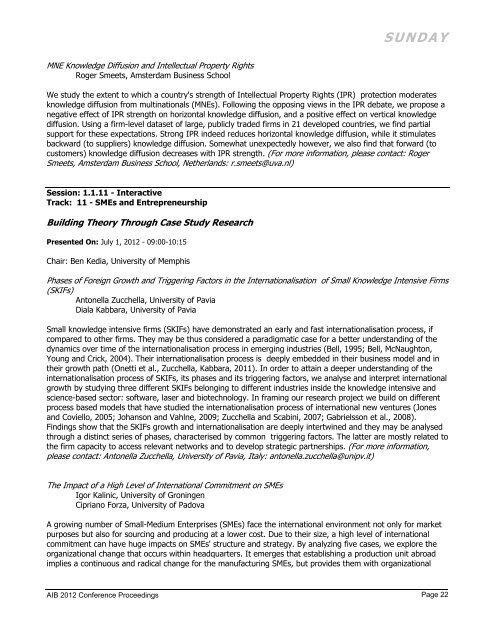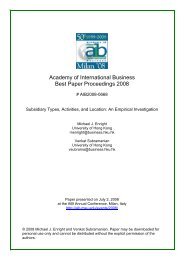AIB 2012 Conference Proceedings - Academy of International ...
AIB 2012 Conference Proceedings - Academy of International ...
AIB 2012 Conference Proceedings - Academy of International ...
You also want an ePaper? Increase the reach of your titles
YUMPU automatically turns print PDFs into web optimized ePapers that Google loves.
SUNDAY<br />
MNE Knowledge Diffusion and Intellectual Property Rights<br />
Roger Smeets, Amsterdam Business School<br />
We study the extent to which a country's strength <strong>of</strong> Intellectual Property Rights (IPR) protection moderates<br />
knowledge diffusion from multinationals (MNEs). Following the opposing views in the IPR debate, we propose a<br />
negative effect <strong>of</strong> IPR strength on horizontal knowledge diffusion, and a positive effect on vertical knowledge<br />
diffusion. Using a firm-level dataset <strong>of</strong> large, publicly traded firms in 21 developed countries, we find partial<br />
support for these expectations. Strong IPR indeed reduces horizontal knowledge diffusion, while it stimulates<br />
backward (to suppliers) knowledge diffusion. Somewhat unexpectedly however, we also find that forward (to<br />
customers) knowledge diffusion decreases with IPR strength. (For more information, please contact: Roger<br />
Smeets, Amsterdam Business School, Netherlands: r.smeets@uva.nl)<br />
Session: 1.1.11 - Interactive<br />
Track: 11 - SMEs and Entrepreneurship<br />
Building Theory Through Case Study Research<br />
Presented On: July 1, <strong>2012</strong> - 09:00-10:15<br />
Chair: Ben Kedia, University <strong>of</strong> Memphis<br />
Phases <strong>of</strong> Foreign Growth and Triggering Factors in the <strong>International</strong>isation <strong>of</strong> Small Knowledge Intensive Firms<br />
(SKIFs)<br />
Antonella Zucchella, University <strong>of</strong> Pavia<br />
Diala Kabbara, University <strong>of</strong> Pavia<br />
Small knowledge intensive firms (SKIFs) have demonstrated an early and fast internationalisation process, if<br />
compared to other firms. They may be thus considered a paradigmatic case for a better understanding <strong>of</strong> the<br />
dynamics over time <strong>of</strong> the internationalisation process in emerging industries (Bell, 1995; Bell, McNaughton,<br />
Young and Crick, 2004). Their internationalisation process is deeply embedded in their business model and in<br />
their growth path (Onetti et al., Zucchella, Kabbara, 2011). In order to attain a deeper understanding <strong>of</strong> the<br />
internationalisation process <strong>of</strong> SKIFs, its phases and its triggering factors, we analyse and interpret international<br />
growth by studying three different SKIFs belonging to different industries inside the knowledge intensive and<br />
science-based sector: s<strong>of</strong>tware, laser and biotechnology. In framing our research project we build on different<br />
process based models that have studied the internationalisation process <strong>of</strong> international new ventures (Jones<br />
and Coviello, 2005; Johanson and Vahlne, 2009; Zucchella and Scabini, 2007; Gabrielsson et al., 2008).<br />
Findings show that the SKIFs growth and internationalisation are deeply intertwined and they may be analysed<br />
through a distinct series <strong>of</strong> phases, characterised by common triggering factors. The latter are mostly related to<br />
the firm capacity to access relevant networks and to develop strategic partnerships. (For more information,<br />
please contact: Antonella Zucchella, University <strong>of</strong> Pavia, Italy: antonella.zucchella@unipv.it)<br />
The Impact <strong>of</strong> a High Level <strong>of</strong> <strong>International</strong> Commitment on SMEs<br />
Igor Kalinic, University <strong>of</strong> Groningen<br />
Cipriano Forza, University <strong>of</strong> Padova<br />
A growing number <strong>of</strong> Small-Medium Enterprises (SMEs) face the international environment not only for market<br />
purposes but also for sourcing and producing at a lower cost. Due to their size, a high level <strong>of</strong> international<br />
commitment can have huge impacts on SMEs' structure and strategy. By analyzing five cases, we explore the<br />
organizational change that occurs within headquarters. It emerges that establishing a production unit abroad<br />
implies a continuous and radical change for the manufacturing SMEs, but provides them with organizational<br />
<strong>AIB</strong> <strong>2012</strong> <strong>Conference</strong> <strong>Proceedings</strong><br />
Page 22

















